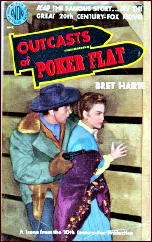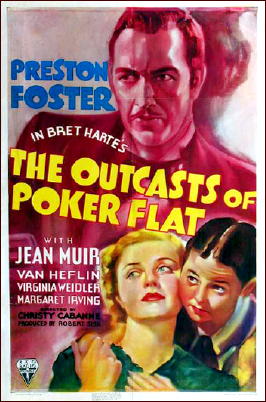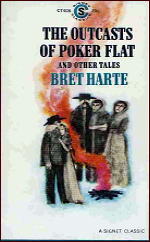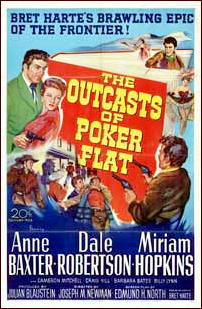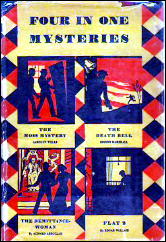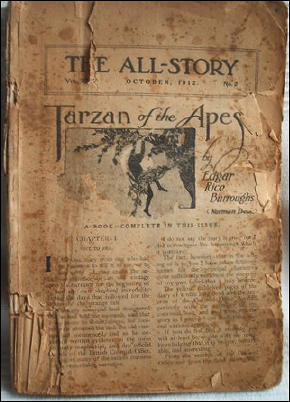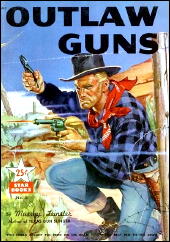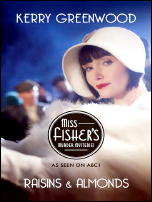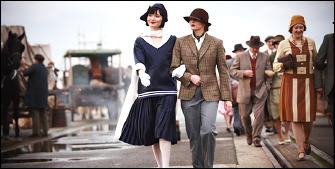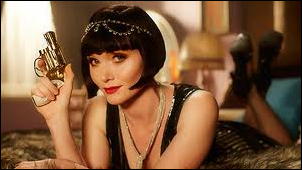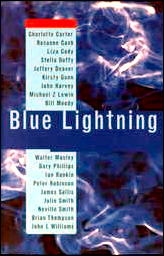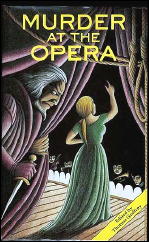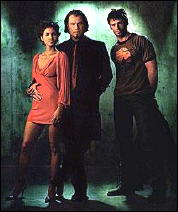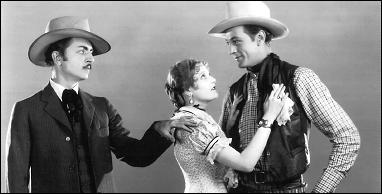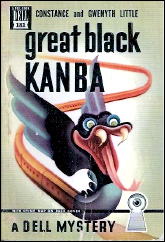ADVENTURES IN COLLECTING
THE ALL-STORY October 1912: The First Tarzan Novel
by Walker Martin
When I was 9 years old, the first books that I read on my own were the Tarzan and Mars novels by Edgar Rice Burroughs. I knew what I would try and save if the house ever caught on fire. I loved the novels and eventually got hooked on science fiction and adventure fiction. So much so, that I now have complete or extensive runs of just about every major adventure and general fiction pulp, not to mention collecting the majority of SF magazines.
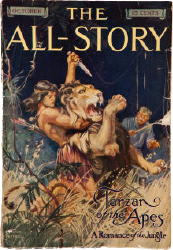
Yet I’ve never considered myself a Burroughs collector. I don’t collect the first edition hardcovers, and I’ve never attended the annual Dum Dum Burroughs convention. However since I collect All Story, Argosy, and Bluebook, I’m constantly running into the problem that many collectors have to face; and that is the fact that if you want to collect these magazines, then you are going to have to pay a premium in order to get the Burroughs issues. He appeared quite often in all three titles and these issues can command high prices simply because Burroughs is in them.
In fact, one of the issues is considered The Holy Grail of pulp collectors. Yes, I’m talking about ALL STORY, October 1912, containing the complete novel, Tarzan of the Apes. If ever a title of a novel deserved to be in capital letters, then that certainly applies to the first Tarzan novel. Tarzan, even a hundred years later, is still one of the most popular and iconic characters ever created.
Many years ago, it used to be possible to play the game that all collectors love. What is the most valuable first edition SF novel, detective novel, etc. Magazine collectors of course would wonder about the most valuable pulp. I can remember old time collectors discussing and voting for the first issue of Weird Tales (I actually found the second issue to be rarer), the first Dashiell Hammett issue of Black Mask, Thrill Book, etc. Some collectors would even pick an issue of some obscure, one shot magazine like Strange Suicides or Zeppelin Stories.
But now I would have to say that it is no longer possible to play the game of “The Most Valuable Pulp Is…” Why? Because there is only one possible answer: All Story October 1912. I have seen a beat up copy go for over $25,000, a nicer copy at auction sell for over $50,000. It is evidently a very rare and hard to find magazine in addition to being the most valuable.
I collect All Story, which during 1905-1920 printed many early SF stories. It was mainly a weekly during this period published by Munsey and lasted over 400 issues until being finally absorbed by Argosy in 1920. I lack only 4 or 5 issues of having a complete set. Needless to say, the October 1912 issue is one of the missing dates. This then is the story of my quest for that issue, an adventure that has been an obsession for many decades.
Several times I have had the opportunity of acquiring the issue and each time I failed. My failures I see as a combination of stupidity, bad luck, and not being rich. The first time I was offered the October 1912 issue was over 30 years ago when a fellow Trenton collector casually mentioned that he knew someone that had the issue and was willing to sell. Trying my best to appear casual and bored, I said “Yeah, what’s he want for it. Huh?” All serious collectors know that you must appear like obtaining the book or magazine is the last thing in the world that you want to do.
He wanted $1,500 which back in the early days of pulp collecting was a lot of money. I could just about come up with the sum despite having the usual roadblocks such as mortgage, wife, and children. The only problem was that the owner was elderly and evidently on his last legs. My friend would not tell me his name and address but would broker the deal. All I had to do was pay him the cash and he would send it off to pay for the issue. However, he warned me that if the owner croaked, then I would be out of luck.
This turned out to be a deal breaker. All collectors worry about sending off large sums of money and then hearing that death has cancelled the deal. It’s kind of hard saying to a widow, “Hey I’m sorry so and so died. By the way he owes me $1,500”.
The second time was in the 1980’s at several Pulpcons. Each year I used to see Winston Dawson, an elderly collector who always showed up with his wife (a practice I’m violently against by the way). At one point I would have to say Winston was the oldest Pulpcon attendee, definitely in his mid-80’s. We often had discussions about All Story and it became apparent that he had The Holy Grail. As he grew older, he became more and more willing to sell the issue to me. I guess he wanted to find it a nice home with a younger collector.
However, once again the subject of death came up. Just when we were about to conclude the deal, Winston up and died. The next couple years Pulpcon held auctions of the Winston Dawson Collection. I must of looked at every pulp he ever owned. One year hundreds of pulps were stacked on the floor waiting to be auctioned and I actually groveled and crawled along the floor, hoping to find the October 1912 issue. Someone must of got it before me because it was not there.
A few years later, up for auction at Pulpcon, came the issue! Maybe it was even the missing Winston Dawson copy! The only problem was that it was lacking the Tarzan novel. Now, many people may not be aware that at one time there existed quite a number of old time collectors who enjoyed excerpting their favorite authors and stories and making little homemade books. Some of these guys did not have any idea of what they were doing and ruined quite a few magazines.
They would cut or rip out the pages or maybe take out the staples, etc. Then make up a cover and staple the stories together so that they had sort of a book. Some collectors even had the pages professionally bound and some, like Harry Noble, learned how to bind books so he could make a decent looking book.
Then you could have a book of H. Bedford Jones or Max Brand stories. This was all before The Golden Age of Pulp Reprints. This is the age we live in now with excellent reprints from Altus Press, Black Dog Books, Murania Press, John Locke, Girosal Press, and others. Now you don’t need to break up pulps and make your own book. So all these old time collectors are gone now, except for one misguided soul who continues to excerpt pulps, and this is evidently what happened with the Tarzan issue up at auction at Pulpcon.
Someone had excerpted the Tarzan novel and the covers. What was left was the rest of the magazine in quite nice condition but without the important pages. Now you might think that this item would be laughed at and forgotten. Not so. Because the Tarzan issue is so rare and expensive, even a poor, cut up copy will be of interest to collectors in the know. The bidding was hot and furious starting off at $10. I won it at $400 and figured this was as close as I’d ever come to having the issue I’d been searching for so long.
Fast forward into the 1990’s and I’m at my senseless office job supervising non-collectors, when one day I get a phone call from pulp collector and author Frank Robinson. Due to my habit of talking about the October 1912 issue so often, he knew I was still in the hunt for it. He explained he was at an auction on the East Coast and the Tarzan issue was coming up for bids. What did I want to bid for it? For some reason I only said $5,000 and of course it went higher than that figure. Again, I was out of luck. Maybe if I’d been at the auction, I would have been successful.
Now here we are in December 2012 and I still don’t have the Tarzan novel. I have the October 1912 issue but the novel is missing. As usual I’m complaining about my situation in a pulp discussion group online, when another collector tells the story of how he was at the Dum Dum Burroughs convention and saw a coverless issue sell for only $25. Not only that but he noticed a coverless issue is up on eBay.
At this point in my life, I know I’m not going to pay $50,000 or so for one of my wants. It just is not going to happen. But I will be glad to get a coverless issue at a far lower price. The eBay copy is owned by a seller in the UK and he wants a minimum bid of 600 pounds, which is almost a thousand dollars. I figure that price is ok and finally I can stop being obsessed by October 1912! Toward the end of the auction another collector enters a bid and now I have to think about just how high do I want to go? I finally decide on $1,500. This I am willing to pay to get the issue and get some peace of mind.
The seller tells me that he obtained it in England 15 or 20 years ago and recognized that it was something special. He had no idea how it got to England from America. My bid of $1500 is successful and I finally get the issue that I’ve been hunting for so long. And get this. It arrives on Christmas Eve! This is a tale to bring tears to the eyes of any pulp collector during the Christmas Holidays. Talk about the spirit of Christmas! It’s another bloody Christmas Story, A Christmas Carol!
So now, here I sit with not one issue of the October 1912 All Story but two issues. True, one lacks the Tarzan novel and one lack the covers but beggars can’t be choosers and neither can collectors. Is it possible that in all the entire world, I am the only person with two copies of the October 1912 issue? Ah Bliss!
